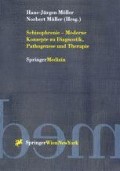Zusammenfassung
Die Ergebnisse zahlreicher Zwillingsuntersuchungen und epidemiologischgenetischer Studien sprechen eindeutig dafür, daß genetische Faktoren bei schweren psychischen Störungen, insbesondere den sogenannten endogenen Psychosen, eine bedeutende Rolle spielen (Kendler 1988, Tsuang und Faraone 1990). Nach wie vor stellt aber die Definition und Abgrenzung des Phänotyps eines der Hauptprobleme der genetisch orientierten Forschung in der Psychiatrie dar. Gesucht werden beobachtbare Einheiten, denen gemeinsame Genotypen zugrunde liegen. Die richtige Phänotypdefinition ist eine wesentliche Voraussetzung für die Aufklärung des genetischen Übertragungsmodus und der Lokalisation von Krankheitsgenen (Maier und Propping 1991). Die Definition von Phänotypen nach gängigen klinisch-diagnostischen Schemata scheint nur begrenzt für genetische Analysen geeignet zu sein (Tsuang et al. 1992). Zwar brachte die Einführung kriterienorientierter Klassifikationssysteme eine Verbesserung der Rehabilität von Diagnosen, es bestehen aber erhebliche Zweifel an deren genetischer Validität. Phänotypdefinitionen enthalten prinzipiell zwei Fehlermöglichkeiten: Sie können einerseits Phänokopien und damit falsch positive Fälle umfassen und andererseits beim Vorkommen von Pleiotropien falsch negative Entscheidungen enthalten. Als genetische Phänotypmarker betrachtet man beobachtbare Merkmale auf biochemischer, psychophysiologischer oder Verhaltensebene, die Phänotypen genetisch valide anzeigen.
Access this chapter
Tax calculation will be finalised at checkout
Purchases are for personal use only
Preview
Unable to display preview. Download preview PDF.
Literatur
Abel LA, Ziegler AS (1988) Smooth pursuit eye movements in schizophrenics — what constitutes quantitative assessment? Biol Psychiatry 24: 747–761
Arolt V, Steege D, Nolte A (1993) Störungen der Augenbewegungen bei Schizophrenen — kritische Übersicht und zukünftige Perspektiven. Fortschr Neurol Psychiatr 61: 90–105
Baron M, Gruen R, Rainer JD, Kane J, Asnis L, Lord S (1985) A familiy study of schizophrenic and normal control probands: implications for the spectrum concept of schizophrenia. Am J Psychiatry 142: 447–455
Blackwood DH, St Clair DM, Muir WJ, Duffy JC (1991a) Auditory P300 and eye tracking dysfunction in schizophrenic pedigrees. Arch Gen Psychiatry 48: 899–909
Blackwood D, St Clair D, Muir W (1991b) DNA markers and biological vulnerability markers in families multiply affected with schizophrenia. Eur Arch Psychiatry Clin Neurosci 240: 191–196
Clementz BA, Sweeney JA, Hirt M, Haas G (1990) Pursuit gain and saccadic intrusions in first-degree relatives of probands with schizophrenia. J Abnorm Psychol 99: 327–335
Erlenmeyer-Kimling L (1987) Biological markers for the liability to schizophrenia. In: Heimchen H, Henn FA (eds) Biological perspectives of schizophrenia. Wiley, New York, pp 33–56
Gershon ES, de Lisi LE, Hamovit J, Nurnberger JI, Maxwell ME, Schreiber J, Dauphinais D, Dingman CW, Guroff JJ (1988) A controlled familiy study of chronic psychosis. Arch Gen Psychiatry 45: 328–336
Gooding DC, Iacono WG, Katsanis J, Beiser M, Grove WM (1993) The association between lithium carbonate and smooth pursuit eye tracking among first-episode patients with psychotic affective disorders. Psychophysiology 30: 3–9
Grove WM, Clementz BA, Iacono WG, Katsanis J (1992) Smooth pursuit ocular motor dysfunction in schizophrenia: evidence for a major gene. Am J Psychiatry 149: 1362–1368
Holzman PS (1992) Behavioral markers of schizophrenia useful for genetic studies. J Psychiatr Res 26: 427–445
Holzman PS, Solomon CM, Levin S, Waternaux CS (1984) Pursuit eye movement dysfunctions in schizophrenia. Family evidence for specificity. Arch Gen Psychiatry 41: 136–139
Iacono WG, Moreau M, Beiser M, Fleming JA, Lin TY (1992) Smooth-pursuit eye tracking in first-episode psychotic patients and their relatives. J Abnorm Psychol 101: 104–116
Kendler KS (1988) The genetics of schizophrenia. In: Dunner DL, Gershon ES, Barret JE (eds) Relatives at risk for mental disorders. Raven, New York, pp 247–266
Levy D, Holzman P, Matthysse S, Mendell N (1994) Eye tracking and schizophrenia: a selective review. Schizophr Bull 20: 47–62
Maier W, Propping P (1991) Die familiäre Häufung psychischer Störungen und die Konsequenzen für die psychiatrische Diagnostik. Nervenarzt 62: 298–407
Sweeney JA, Clementz BA, Haas GL, Escobar MD, Drake K, Frances AJ (1994) Eye tracking dysfunction in schizophrenia: characterization of component eye movement abnormalities, diagnostic specificity, and the role of attention. J Abnorm Psychol 103: 222–230
Taylor MA (1992) Are schizophrenia and affective disorder related? A selective literature review. Am J Psychiatry 149: 22–32
Tsuang MT, Faraone SV (eds) (1990) The genetics of mood disorders. Johns Hopkins University Press, Baltimore
Tsuang MT, Lyons MJ, Faraone SV (1992) Clinical phenotypes: problems in diagnosis. In: Mendlewicz J, Hippius H (eds) Genetic research in psychiatry. Springer, Berlin Heidelberg New York, pp 173–187
Author information
Authors and Affiliations
Editor information
Editors and Affiliations
Rights and permissions
Copyright information
© 1998 Springer-Verlag Wien
About this paper
Cite this paper
Kathmann, N., Hochrein, A., Bondy, B. (1998). Störungen langsamer Augenfolgebewegungen als Vulnerabilitätsmarker der Schizophrenie. In: Möller, HJ., Müller, N. (eds) Schizophrenie — Moderne Konzepte zu Diagnostik, Pathogenese und Therapie. Springer, Vienna. https://doi.org/10.1007/978-3-7091-6471-6_12
Download citation
DOI: https://doi.org/10.1007/978-3-7091-6471-6_12
Publisher Name: Springer, Vienna
Print ISBN: 978-3-211-83086-4
Online ISBN: 978-3-7091-6471-6
eBook Packages: Springer Book Archive

